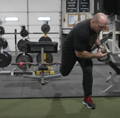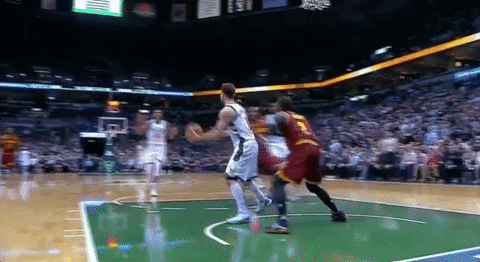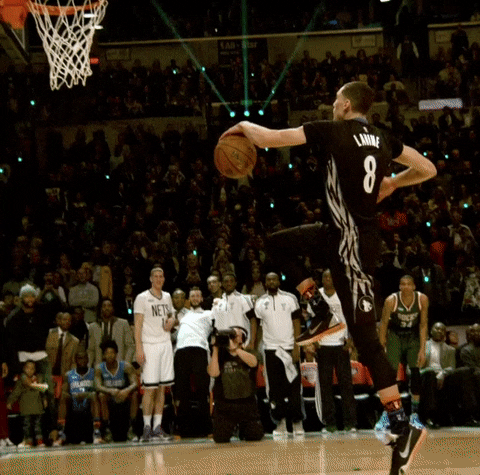Basketball Speed Workout
In the sport of basketball, we have to look at what that speed entails. There is a little buzzword I’m going to use known as transient speed. Usually, we think of speed in the manner of Usain Bolt sprinting down a 100-meter track or a wide receiver in football taking off and having long duration speed. Transient speed is more specific to basketball and other sports.

See, when we break down Usain Bolt we are looking at the start, the drive phase/acceleration, and then into maximal mechanics. That never happens on the basketball court. We have to look at transient speed: starting and stopping as quickly as possible, being agile as possible, and that is all achieved through more work with acceleration through different positions and angles, reactiveness, and through lateral movement as well as forward and backward. Transient speed is the main concept we have to think about when understanding speed for basketball. Everything is based on start and stopping with max acceleration.
Before we get into the four exercises, I recommend basketball players do sled pulls or backward sled pulls two to three times a week to further develop their quads and calves so that their body is able to absorb all the energy from landing, heal and recover from all the different forces the knees and hips take on, and the wear and tear on the body from playing the sport of basketball.
1. Pogo Jumps
I like to think of Ja Morant who dominates with transient speed throughout the court. Speedy point guards exhibit dynamic trunk control. It is seen through their agility and quick moves.
To be really reactive, the first exercise needs to be pogo jumps. We do this to warm up our ankle patterning. We want to focus on stronger feet, mobile ankle joints, and the Achilles being warmed up.
Pogo jumps are done bilaterally. We want to think when we land mid-foot forward. These can be done at home for two to three sets for ten to fifteen reps with really quick reactions. Feel the ankles behave exactly like a pogo stick.
2. Kettlebell Lateral Side Jumps
This movement is reminiscent of Kyrie Irving breaking ankles. The exercise really helps with lateral acceleration and deceleration. The key factor behind speed is being able to control deceleration. This exercise enhances our ability to stop. We can do some stop drills, declaration drills, to start and then focus on the quick amortization phase, landing and reacting as quickly as possible.

As the body gets more advance jumping from side to side, we can start to turn the trunk to get more focus on dynamic trunk control. Starting with the pause in the landing in the unilateral landings, we can then bound side to side without a pause once warmed up. It can be done five to six sets for three to four reps on each leg. Do this twice a week to improve lateral movement.
3. Depth Drop To Bilateral Bound To Unilateral Landing
As the body gets more advance jumping from side to side, we can start to turn the trunk to get more focus on dynamic trunk control. Starting with the pause in the landing in the unilateral landings, we can then bound side to side without a pause once warmed up. It can be done five to six sets for three to four reps on each leg. Do this twice a week to improve lateral movement.

To do this movement, we need to step off a box, or if outside, a bench, and land on two feet. Immediately upon landing, bilaterally jump and land on a single leg. Alternate which foot is landed on each jump.
We can make the movement more advanced. We can go bound, bound, land single leg. Landing unilaterally and bilaterally carries over very well to the court. We never know how we will ground. It is important that we train these skills in the weight room.
Start by doing this movement once a week and then build into doing it twice a week for five or six sets.

4. Lateral Power Skip
Think of Zach Lavine, one of the most athletic guys in the entire league, an explosive freak in the NBA. This exercise can be used to improve defensive movements to be more explosive laterally moving side to side.

There is a rhythm to this movement. It is a single leg jump laterally to landing on the other foot. The jumping foot needs to quickly ground after the non-jumping leg lands. And then the movement needs to happen again. The exercise is fantastic but requires a high level of coordination.
Recap
Basketball players need to be able to apply force to be able to accelerate and decelerate as quickly as possible to improve play on the court.
Get creative with these movements. Get to the court early and get a good warm-up in. These movements do not need to be done in a gym. They can be done anywhere inside or outside, as long as the ceiling is high enough to contain the hops.
DANE MILLER
Dane Miller is the owner and founder of Garage Strength Sports Performance. He works with a select handful of clients on building comprehensive programs for fitness and nutrition. Several times a year he leads a workshop for coaches, trainers, and fitness enthusiasts.


